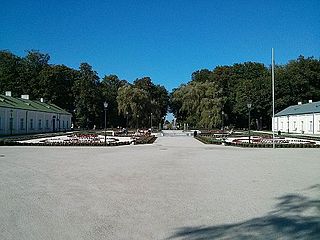
Świętokrzyskie Voivodeship, also known as Świętokrzyskie Province, and Holy Cross Voivodeship, is a voivodeship (province) in southeastern Poland, in the historical region of Lesser Poland. The province's capital and largest city is Kielce.

Kielce Voivodeship is a former unit of administrative division and the local government in Poland. It was originally formed during Poland's return to independence in the aftermath of World War One, and recreated within the new Polish borders after the defeat of Nazi Germany in World War Two.

Końskie is a town in south-central Poland with 20,328 inhabitants (2008), situated in the Świętokrzyskie Voivodeship. Historically, Końskie belongs to the province of Lesser Poland, and since its foundation, until 1795, it was part of Lesser Poland's Sandomierz Voivodeship.
Kamieniec may refer to several places:

Nowy Korczyn is a small town in Busko County, Świętokrzyskie Voivodeship, in south-central Poland. It is the seat of the gmina called Gmina Nowy Korczyn. It lies in Lesser Poland, approximately 20 kilometres (12 mi) south of Busko-Zdrój and 67 km (42 mi) south of the regional capital Kielce. It is located close to the confluence of the Nida and the Vistula rivers. Nowy Korczyn was a town from 1258 to 1869.

Szydłów is a fortified town in Staszów County, Świętokrzyskie Voivodeship, in southeastern Poland. It is the seat of the gmina called Gmina Szydłów. It lies approximately 13 kilometres (8 mi) west of Staszów and 43 km (27 mi) south-east of the regional capital Kielce.

Staszów is a town in southeastern Poland, in Świętokrzyskie Voivodeship, about 54 kilometres southeast of Kielce, and 120 km (75 mi) northeast of Kraków. It is the capital of Staszów County. The population is 15,108 (2010), which makes it the 8th largest urban center of the province. The area of the town is 26,88 km2, and its two rivers are the Desta and the Czarna Staszowska.

Chęciny is a town in Kielce County, Świętokrzyskie Voivodeship, southern Poland, with 4,361 inhabitants as of December 2021. It was first mentioned in historical documents from 1275, and obtained its city charter in 1325. At that time was one of major urban centers of northern Lesser Poland. The most important sight in Chęciny is the royal castle built in the late 13th or early 14th century on the Castle Hill above the town. It fell into a ruin in the 18th century and remains in that state to this day. For centuries Chęciny had a Jewish community and it had been the center of the Hasidic Chentshin dynasty,
Górki may refer to the following places in Poland:

The Kielce pogrom of 1918 refers to the events that occurred on 11 November 1918, in the Polish city of Kielce located in current Świętokrzyskie Voivodeship. According to 1919 Report by Henry Morgenthau, Sr. who led the Mission of The United States to Poland; during Poland's fight for independence towards the end of the First World War, shortly after the Austro-Hungarian troops were evacuated from Kielce by their military command, the city authorities allowed local Jewish community to hold a rally at the Polish Theatre. The participants rallied behind the Jewish demand for political and cultural autonomy. According to one U.S. source, during the rally, anti-Polish speeches were also being delivered. A respected lawyer, Mr. Frajzyngier, who attempted to deliver a public address in Polish was booed. The angry audience shouted: "No Polish language here!" According to Stanisław Białek from the Jan Karski Society, the voices of protest sparked a rumour about the anti-Polish character of the meeting. As the meeting went on, a crowd of Polish onlookers gathered outside the theatre.
Podzamcze may refer to the following places:
Bugaj may refer to the following places:
Gruszka is a Polish place name. It may refer to:
Włochy is a district of Warsaw.
This page is based on this
Wikipedia article Text is available under the
CC BY-SA 4.0 license; additional terms may apply.
Images, videos and audio are available under their respective licenses.







